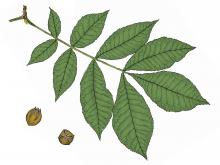Trees, Shrubs and Woody Vines
Media

Species Types
Scientific Name
Quercus lyrata
Description
Overcup oak is fairly easy to identify. The acorns are almost completely covered by their knobby cups. The leaves have long, narrow lobes and wide sinuses. In Missouri, it grows naturally only in wet forests along the Mississippi and Meramec rivers.
Media

Species Types
Scientific Name
Quercus marilandica
Description
Blackjack oak is common in dry upland woods, especially ones that have been badly burned. It can grow on the poorest soils. It is rugged but not worth much as lumber. It's one of the first trees to be used as fuel.
Media

Species Types
Scientific Name
Quercus alba
Description
Found throughout Missouri and in all kinds of habitats, the white oak is one of our most attractive, long-lived, and stately shade trees. Learn to recognize it by its light gray bark, rounded-lobed leaves, and distinctive acorns.
Media

Species Types
Scientific Name
Sassafras albidum
Description
Sassafras, with its aromatic oval, mitten- , and trident-shaped leaves, is rich in both human and natural history, and it can be a spectacular tree for fall color.
Media

Species Types
Scientific Name
Quercus macrocarpa
Description
Bur oaks can live for hundreds of years and become giants; many have legendary or historic status. As with most oak species, it can be identified by leaf shape.
Media

Species Types
Scientific Name
Carya texana
Description
Black hickory's nut, like that of the pignut hickory, is awfully hard to crack. Because rural Ozarkers noticed their hogs had no trouble extracting the sweet kernels, both species came to be called "pignut hickories."
Media

Species Types
Scientific Name
Carya cordiformis
Description
Of the several hickories in Missouri, bitternut hickory is the only one with long, bright yellow buds. Its common name refers to the bitter taste of the nut — but the flavor doesn't put off squirrels, mice, and deer!
Media

Species Types
Scientific Name
Carya illinoinensis
Description
The pecan, a type of hickory, is one of Missouri’s favorite nut trees. Originally pecan had a fairly limited, southern distribution, but today it is found in and out of cultivation nearly statewide, owing to the popularity of the nuts.
Media

Species Types
Scientific Name
Elaeagnus umbellata
Description
Autumn olive can be found all over the state, since it was planted widely with the best of intentions. Despite its “pros,” this shrub has proven to be very invasive. It threatens native ecosystems and should not be planted.
Media

Species Types
Scientific Name
Lonicera maackii (Amur) and Lonicera x bella (bella)
Description
If there’s a giant green thicket in your woods, you may have a bush honeysuckle infestation. These invasive plants are shrubby natives of Asia. In America, where they have no natural controls, they leaf out early, grow fast, spread fast, and form dense thickets that crowd out native forest plants.
See Also
About Trees, Shrubs and Woody Vines in Missouri
There are no sharp dividing lines between trees, shrubs, and woody vines, or even between woody and nonwoody plants. “Wood” is a type of tissue made of cellulose and lignin that many plants develop as they mature — whether they are “woody” or not. Trees are woody plants over 13 feet tall with a single trunk. Shrubs are less than 13 feet tall, with multiple stems. Vines require support or else sprawl over the ground.





















